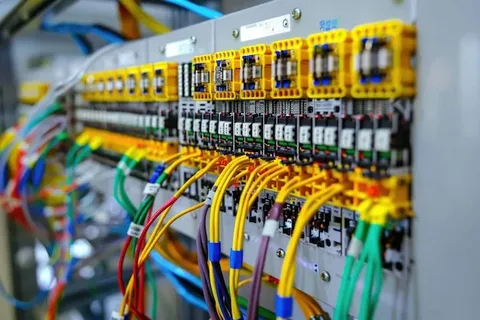| Introduction The Distribution Automation Market is a cornerstone of the global effort to modernize electrical grids, ensuring higher reliability, efficiency, and flexibility in power distribution. Distribution automation (DA) involves using advanced monitoring, communication, and control technologies to manage distribution networks in real time. These systems help detect and isolate faults, optimize load flow, and improve overall network performance. With growing urbanization, rising electricity demand, and the increasing complexity of distributed energy resources (DERs), the need for intelligent and automated grid operations is stronger than ever. DA is not only improving energy reliability but also enabling utilities to adapt to renewable integration, electrification of transport, and dynamic consumer energy behavior — making it a key enabler of the digital grid revolution. Market Drivers The rapid digitalization of power infrastructure is one of the primary drivers of the Distribution Automation Market. Utilities across the world are investing heavily in smart grids and advanced distribution management systems (ADMS) to improve operational efficiency. Rising renewable energy adoption has made grid operations more variable, creating a need for real-time visibility and automation. Governments and regulatory bodies are mandating grid modernization projects and supporting investments in smart infrastructure through incentives and funding programs. The increasing frequency of extreme weather events and power outages has also driven utilities to deploy self-healing grid technologies that can automatically detect and resolve faults. Furthermore, advancements in IoT, cloud computing, and communication technologies are making DA systems more accessible, scalable, and cost-efficient for both developed and developing regions. Market Challenges Despite the immense potential, the Distribution Automation Market faces several challenges. The high upfront investment required for hardware, software, and communication infrastructure continues to be a major obstacle, especially for utilities with limited budgets. Integrating DA with legacy grid systems can be technically complex and time-consuming. Cybersecurity threats pose another significant risk, as automation and connectivity increase the surface area for potential cyberattacks. In addition, a shortage of skilled professionals capable of handling advanced grid technologies limits widespread adoption. Regulatory uncertainties and inconsistent policy frameworks across regions can also slow down implementation. Data management — particularly handling the massive flow of information from distributed devices — remains another major challenge for utilities aiming to maintain operational efficiency and security. Market Opportunities The Distribution Automation Market presents tremendous opportunities for innovation and growth. The expansion of microgrids and the growing adoption of distributed generation create strong demand for DA systems capable of coordinating local energy flows efficiently. The rise of electric vehicles (EVs) offers new opportunities for load management and demand response through automated systems. Cloud-based DA solutions and AI-driven analytics platforms are emerging as powerful tools for predictive maintenance, fault analysis, and decision-making. Furthermore, the development of interoperable standards and open communication protocols will simplify integration with legacy infrastructure. In developing economies, large-scale rural electrification projects and smart city initiatives present massive potential for deploying automated distribution systems. As energy storage becomes more common, DA will play a critical role in ensuring smooth power flow between storage assets, renewables, and the grid. Regional Insights Regionally, North America leads the Distribution Automation Market, driven by early adoption of smart grid technologies and strong governmental initiatives. The United States, in particular, has seen widespread deployment of DA systems to enhance grid reliability and resilience. Europe follows closely, with countries like Germany, the UK, and France focusing on renewable integration and digital infrastructure upgrades under the EU’s energy transition goals. The Asia-Pacific region is witnessing the fastest growth, supported by massive urbanization, increasing electricity consumption, and national grid modernization programs in countries such as China, India, and Japan. In the Middle East and Africa, DA adoption is gaining traction as governments invest in upgrading aging infrastructure and improving grid resilience. Latin America, led by Brazil and Mexico, is also making strides toward automation to reduce energy losses and improve distribution efficiency. Future Outlook The future of the Distribution Automation Market is bright and transformative. With the ongoing global energy transition, DA will be essential in balancing power from distributed resources, improving efficiency, and minimizing outages. The integration of artificial intelligence, edge computing, and blockchain will revolutionize grid transparency and automation. Utilities will increasingly rely on predictive analytics to preempt equipment failures and manage load demand dynamically. The shift toward “autonomous grids” — systems that can self-diagnose and self-optimize — represents the next major milestone in distribution automation. Furthermore, collaborative efforts between technology providers, regulators, and utilities will accelerate the adoption of interoperable, secure, and scalable DA solutions worldwide. Conclusion In conclusion, the Distribution Automation Market is redefining how electricity is delivered, managed, and optimized. It stands at the intersection of energy, technology, and sustainability, enabling smarter and more adaptive power systems. Despite challenges such as high capital costs and cybersecurity concerns, the long-term benefits — including improved reliability, reduced operational costs, and enhanced renewable integration — make automation indispensable for the future of energy. As digital transformation accelerates, DA will continue to shape the next generation of intelligent, resilient, and sustainable distribution networks worldwide. |
